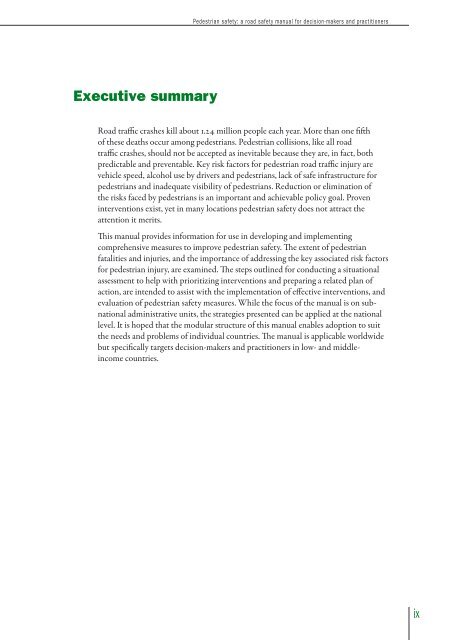Pedestrian safety - Global Road Safety Partnership
Pedestrian safety - Global Road Safety Partnership
Pedestrian safety - Global Road Safety Partnership
Create successful ePaper yourself
Turn your PDF publications into a flip-book with our unique Google optimized e-Paper software.
<strong>Pedestrian</strong> <strong>safety</strong>: a road <strong>safety</strong> manual for decision-makers and practitioners<br />
Executive summary<br />
<strong>Road</strong> traffic crashes kill about 1.24 million people each year. More than one fifth<br />
of these deaths occur among pedestrians. <strong>Pedestrian</strong> collisions, like all road<br />
traffic crashes, should not be accepted as inevitable because they are, in fact, both<br />
predictable and preventable. Key risk factors for pedestrian road traffic injury are<br />
vehicle speed, alcohol use by drivers and pedestrians, lack of safe infrastructure for<br />
pedestrians and inadequate visibility of pedestrians. Reduction or elimination of<br />
the risks faced by pedestrians is an important and achievable policy goal. Proven<br />
interventions exist, yet in many locations pedestrian <strong>safety</strong> does not attract the<br />
attention it merits.<br />
This manual provides information for use in developing and implementing<br />
comprehensive measures to improve pedestrian <strong>safety</strong>. The extent of pedestrian<br />
fatalities and injuries, and the importance of addressing the key associated risk factors<br />
for pedestrian injury, are examined. The steps outlined for conducting a situational<br />
assessment to help with prioritizing interventions and preparing a related plan of<br />
action, are intended to assist with the implementation of effective interventions, and<br />
evaluation of pedestrian <strong>safety</strong> measures. While the focus of the manual is on subnational<br />
administrative units, the strategies presented can be applied at the national<br />
level. It is hoped that the modular structure of this manual enables adoption to suit<br />
the needs and problems of individual countries. The manual is applicable worldwide<br />
but specifically targets decision-makers and practitioners in low- and middleincome<br />
countries.<br />
ix






